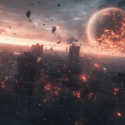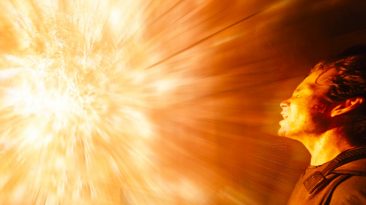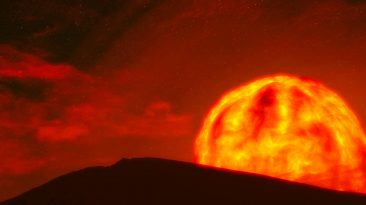Scientists theorize that many millions of years ago, Mars had rings, just like Saturn. And it looks like the red planet could be due for a new set of rings in the future. How exactly would this happen? Would these rings clutter up Martian orbit? And how soon would those new rings start raining down on Mars?
The four gas giants in our Solar System — Jupiter, Uranus, Neptune and Saturn — all have ring systems surrounding them. Of those, Saturn has the largest. And Mars could join this club. Scientists studying Martian moons, Phobos and Deimos, suggest that Mars could have had several more moons. Including one up to 20 times larger than Phobos.
Over billions of years, those moons could have been destroyed and become part of an ancient ring system. Could Phobos and Deimos be next on the Martian moon chopping block?
Phobos is orbiting Mars only about 6,000 km (3,7000 mi) from the planet’s surface. And it’s slowly losing altitude. Eventually, it will reach the Roche Limit. This is the closest a big space body can come to a planet and still be held together by its gravitational forces. For Phobos, the estimated Roche limit is 5,470 km (3,400 mi) from Mars.
At this point, the tidal forces of Mars would start to pull the moon apart. After breaking into carbonaceous chondrite meteorites, the stony rocks and dust would form a thin, dark ring around the planet. You’d find that the smaller Martian moon, Deimos, would still exist. That’s because it orbits Mars at a comfortable 20,069 km (12,470 mi) from the surface.
Deimos would now mark the outer edge of this new ring. This dramatic reshaping of objects in Mars’ orbit could have a big impact on any plans you could have to leave Earth and settle on Mars. Well, maybe not your plans. More like the plans of your future descendants. Scientists expect that Phobos won’t get ripped apart into rings for about 50 million years.
The development of rings around the red planet would be a challenge for space flights. It would be difficult to navigate or transport people and resources. Even the most routine trips on or off Mars would become hazardous rides. And a ring system would block some sunlight, having huge effects on our human settlements on the surface.
Mars is already a frozen planet with an average surface temperature of -63 °C (-81 °F). So things would get even colder. Let’s hope your descendants brought enough warm spacesuits. Even more danger would lie ahead. Eventually, all the objects in the ring would come crashing down on Mars. Big rocks would leave massive new craters on the planet’s surface.
If it’s anything like what happens on Saturn, Martian settlers could face massive storms of rock and dust falling to the surface at 10,000 kg (22,000 lb) per second. The future of humanity would depend on our ability to create new technologies to blast apart these falling objects before they crush us.
Luckily for us, this would happen sometime between 1 million and 100 million years after the ring forms. We’d have plenty of time to come up with a solution. Could we just nuke all those space rocks before they crush our Martian dream?
Sources
- “Exploration | Saturn – NASA Solar System Exploration”. 2022. solarsystem.nasa.gov.
- “How many planets in the Solar System have rings?“. 2022. coolcosmos.ipac.caltech.edu.
- “What is Saturn made of?”. 2022. coolcosmos.ipac.caltech.edu.
- “Centaurs Keep Their Rings From Greedy Gas Giants – Universe Today”. Matt Williams. 2016. universetoday.com.
- “How Was The Moon Formed?”. 2017. space.com.



























